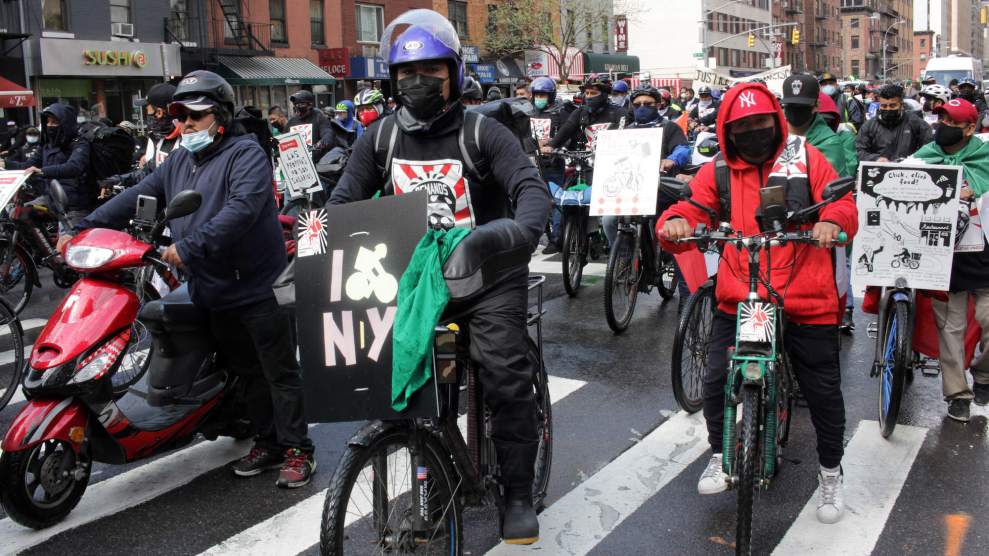
Delivery bike workers at an April protest in New York City organized by Los Deliveristas Unidos, a movement pushing for better conditions for delivery workers.John Marshall Mantel/ZUMA
Two days after ride-hailing and delivery companies succeeded in their $200 million campaign to get California voters to approve a ballot measure that kept their workers classified as independent contractors, Lyft President John Zimmer stressed that he was still open to cutting a deal with the state’s unions. Zimmer wanted a truce with labor and its Democratic allies, who could upend the company’s business model in other states by reclassifying workers as employees.
Seven months later, a version of that strategy is playing out in New York. The state legislature is considering a plan that would allow unions to represent drivers—but with severe restrictions, most notably permanent contractor status for drivers, preventing the state from reclassifying workers. Major players in the gig economy, including Uber and Lyft, have been pushing the bill and hope to see it pass before the end of the legislative session on June 10. They’ve attracted some union support. The Independent Drivers Guild, a nonprofit affiliated with the Machinists Union that’s received funding from Uber, calls the bill a historic opportunity to secure collective bargaining rights for gig workers. To critics, including many in the labor movement, the bill is a sellout, a “sham,” or, simply, “garbage.”
In the absence of congressional action on labor rights, companies in the gig economy know that two of the biggest threats they face are legislation and court decisions in progressive states that will require employee benefits for drivers, such as a guaranteed minimum wage, access to state unemployment insurance, and company-funded health insurance for full-time workers. The New York fight is a preview of a broader effort by the companies to preempt these efforts by striking deals with unions that provide a few concessions in exchange for cementing drivers’ status as contractors. The companies are also lobbying to block employee classification in Colorado, Illinois, Massachusetts, and New Jersey. If they’re successful, hundreds of thousands of workers would be blocked from protections that employees have secured through generations of organizing.
The centerpiece of the New York plan is a framework for letting ride-hail drivers and delivery workers form unions that would engage in what’s known as “sectoral bargaining.” There would be one sector-wide agreement for drivers and another one for delivery workers.
But unions would be greatly limited in their efforts to seek changes. Under the plan, companies would keep full control over their algorithms, pricing, and operations. As a result, they’d presumably retain the authority to block workers from setting their own rates or rejecting too many assignments. Workers would be guaranteed the minimum wage, but not during the roughly one-third of the time that drivers spend waiting for apps to direct them to new customers. That’s a downgrade for New York City drivers who are already guaranteed the minimum wage for all time spent on the job, including time they spend waiting for a ride.
The bill would bar New York City and other local entities from coming up with their own regulations in the future—cutting off what’s proven to be a powerful source of leverage over the companies. It would also force gig workers to get unemployment benefits through a new corporate-funded system, even through New York judges have already ruled that many of them are eligible for regular unemployment insurance. How much money companies put into the benefits network would be determined at the bargaining table; the bill only requires they provide a “non-zero” amount.
Manny Pastreich, the secretary treasurer of 32BJ Service Employees International Union, an SEIU local with more than 170,000 members in 11 states, believes the two main problems with the bill are that it fails to establish strong, independent representation for workers and that it blocks workers from improving standards at the local level. “Why people would bargain down from the standards that have been put in place makes no sense,” he said.
Pastreich is right that the process by which unions would come to represent gig workers is highly unusual. In a normal union election, the National Labor Relations Board holds a vote after at least 30 percent of workers say they want to unionize. If the union gets a majority of the votes, workers form a union.
Under the New York bill, companies would pick which union gets the first crack at organizing their workers. From there, companies and unions would sign “labor peace agreements” that prevent the unions from striking and picketing (and the companies from attacking them) while they solicit workers’ support. Unlike with normal labor elections, the unions wouldn’t have access to workers’ contact information. Instead, they’d rely on a company-provided platform to communicate with potential members.
Union representation would be established once they have the support of 10 percent of what the bill calls “active network users.” Only a small minority of drivers and delivery workers are likely to meet these criteria, meaning that the unions would win after 10 percent of a fraction of gig workers get on board. Critics fear that this would lead to weak unions that lack the power to force concessions.
The bill is being pushed in the legislature by Sen. Diane Savino, a former labor leader who represents the north end of Staten Island and parts of southern Brooklyn. On the left, Savino is infamous for being the only remaining member of the now-defunct Independent Democratic Conference, a group of Democratic senators who denied their own party a majority in 2011 by caucusing with Republicans.
The plan is for the Independent Drivers Guild to represent ride-hail drivers. Unlike a traditional union, IDG receives an undisclosed portion of its funding from Uber following a 2016 deal under which the group agreed not to challenge drivers’ contractor status. Its biggest win is helping in 2018 to make New York City the first city in the nation to establish a minimum wage for drivers. After expenses and taxes, the rate is equivalent to New York’s $15 minimum wage.
Tina Raveneau, a rideshare driver who’s been organizing with IDG since late 2017, told me she sees the bill as a way to get Uber and Lyft to listen. “I’m a human. I’m not just some thing,” she said. “And with this bill, it will force them to come to the table and hear drivers’ cries.”
Initially, the idea was to have the Retail, Wholesale, and Department Store Union represent workers on the delivery side, but it backed out, and the Transport Workers Union stepped in a few weeks ago to fill that role. On May 17, TWU President John Samuelsen told Bloomberg he was fully behind the bill and that he expected it to pass by the end of the session. The news that a deal was near provoked an immediate backlash from labor experts who feared what it would mean for workers. In a series of combative tweets, Samuelsen responded by branding his critics “Twitter Elites.”
Twitter Elites is an apt description for the detached pseudo intellectual arrogance on full display here, from many who never organized a worker fightback and are more interested in defending their political position then advancing deliverers wages and working conditions. https://t.co/q5iiuazGYX
— John Samuelsen (@TwuSamuelsen) May 23, 2021
Two days later, he withdrew TWU’s support for the bill after Los Deliveristas Unidos, a worker-led movement made up of many of the New York delivery workers he hoped to represent, came out against it. When I spoke to him a few hours later, he lamented that there’d be “very, very limited” outreach to delivery workers before he got involved. He wouldn’t support the bill without Los Deliveristas, but it was also clear that he hoped they could be brought on board. “There are trade unions across New York that are strong supporters of the bill,” he said. “I personally support the goals of this bill.” The New York AFL-CIO has also signaled that it’s open to a deal.
Jonán Mancilla, who works full-time for Relay and DoorDash, is one of the Los Deliveristas leaders who helped organize an April protest that drew more than 2,000 delivery workers. Their demands include guaranteed access to restaurant bathrooms, better protection from e-bike thefts, and a living wage. Despite organizing for months with support from the Worker’s Justice Project, a membership organization that advocates for low-wage workers, Mancilla and other Deliveristas only saw the draft text of the bill after it leaked to the press. “We’ve literally been in the streets organizing,” he told me in Spanish. “It’s unjust that they didn’t even send us a text, a call, or an email asking, ‘What do you think of this legislation?’”
State Sen. Jessica Ramos, who represents a Queens district that’s home to many delivery workers, only saw the draft text following a May 20 briefing attended by Uber, Lyft, DoorDash, Instacart, and the New York AFL-CIO. “The biggest problem with the bill is that there’s no employee classification,” Ramos told me. “But also, there’s no real bargaining and there’s no real representation.” Assemblymember Zohran Mamdani, a newly elected socialist from Queens, called the bill a “roadmap for how [companies] undermine the fight for labor in every single state in the United States.”
Instead of relying on dues, unions would get 10 cents for every ride and delivery gig companies provide. As Labor Notes has reported, ride-hail companies were providing 750,000 rides a day in New York City before the pandemic. Once rides pick back up again, that would mean close to $30 million per year in New York City alone, a massive increase from IDG’s overall revenue of $1.3 million in 2018. Brendan Sexton, IDG’s executive director, defended the 10-cent surcharge by saying he didn’t think it made sense for workers who can barely cover their expenses right now to start paying union dues.
The potential windfall has led to charges that IDG is putting financial gain over workers’ best interests. At a press conference outside Gov. Andrew Cuomo’s New York City office last week, Bhairavi Desai, the executive director of the New York Taxi Workers Alliance, charged that IDG would be a “sham union” beholden to ride-hail companies.
To get a sense of how things might play out if the New York bill became law, it helps to look back at California. Prop 22, the 2020 ballot initiative, guaranteed 120 percent of the minimum wage plus 30 cents a mile during the “engaged time” when drivers have customers in their car or are on their way to pick them up. UC Berkeley’s Labor Center estimated that it worked out to having a wage floor of $5.64 per hour, a little more than a third of what New York City drivers are guaranteed now. For those drivers to keep making what they are today, unions would have to force gig companies to guarantee much more pay than they did in California.
Gig companies sold Prop 22, which carved out drivers and delivery workers from a state law designed to make them employees, as a way of protecting people’s “freedom” as independent contractors while also giving them benefits like a minimum wage that are usually reserved for employees. Uber started letting California workers set their own rates as parts of its effort to argue that drivers really were just entrepreneurs using their platform.
Last month, with Prop 22 on the books, Uber took away their ability to charge what they wanted. It’s also limited drivers’ ability to turn down rides. Nicole Moore, a Lyft driver and organizer with the California group Rideshare Drivers United, said many drivers have been surprised to learn that Prop 22 lets Uber take away the tools the company used to sell the idea that they were truly independent. Veena Dubal, an expert on the gig economy and a law professor at UC Hastings in San Francisco, said the New York bill would solidify a situation similar to the one that’s comes to pass under Prop 22.
For now, the legislation faces an uphill battle. “Passing?” Ramos said when I asked last week if the bill had a chance of becoming law. “I don’t think this language is going to be introduced. Forget passing.” But the bill’s supporters are still trying to save it. A new draft includes a number of technical tweaks that show negotiations are ongoing. According to a source following the negotiations, two of the most significant changes appear designed to win over Los Deliveristas: One would give delivery workers until July 21 to secure new protections at the local level; another would provide them with access to restaurant bathrooms.
Regardless of what happens in Albany next week, the gig companies aren’t going to give up on their campaigns to keep workers classified as contractors. There’s too much at stake. Despite all the benefits of relying on contractors—not needing to follow minimum wage laws, provide health insurance, pay payroll taxes, or allow workers to form traditional unions—gig companies are still hemorrhaging billions of dollars per year. It’s not clear whether they’ll ever be able to make money. If they do, keeping down labor costs will be an essential part of the equation.
For Mancilla, the fact that the initial bill was developed without drivers’ input has a particular sting more than a year into the pandemic. “We’re the ones who kept the city afloat,” he said last week. “We fed the clients who didn’t want to risk their lives…That’s why they call us essential workers. It’s not just a slogan.”















